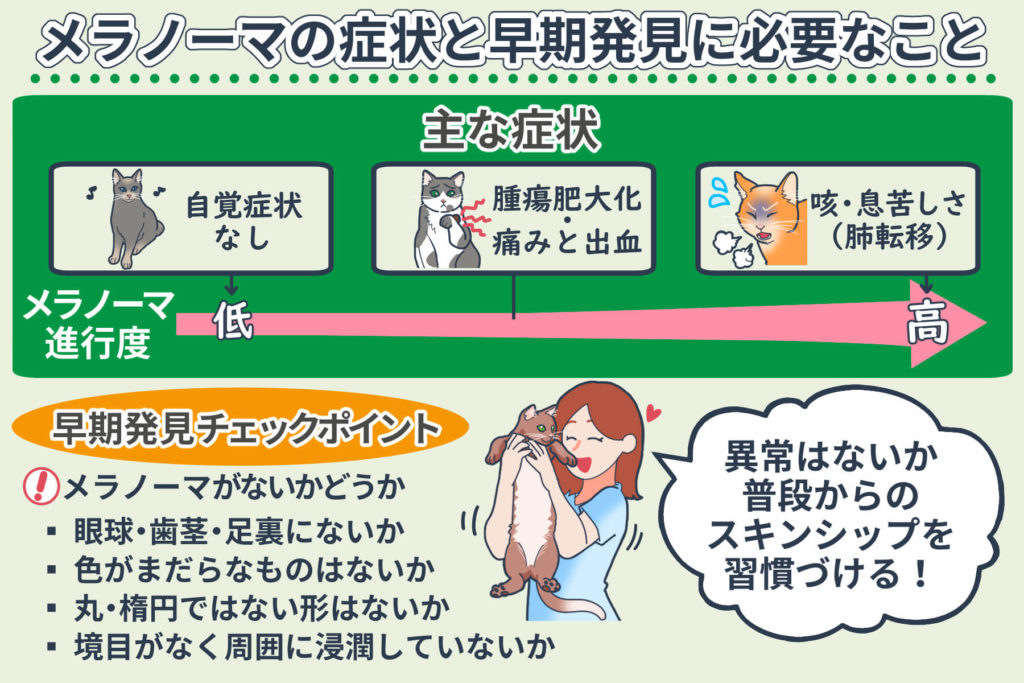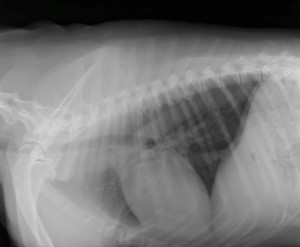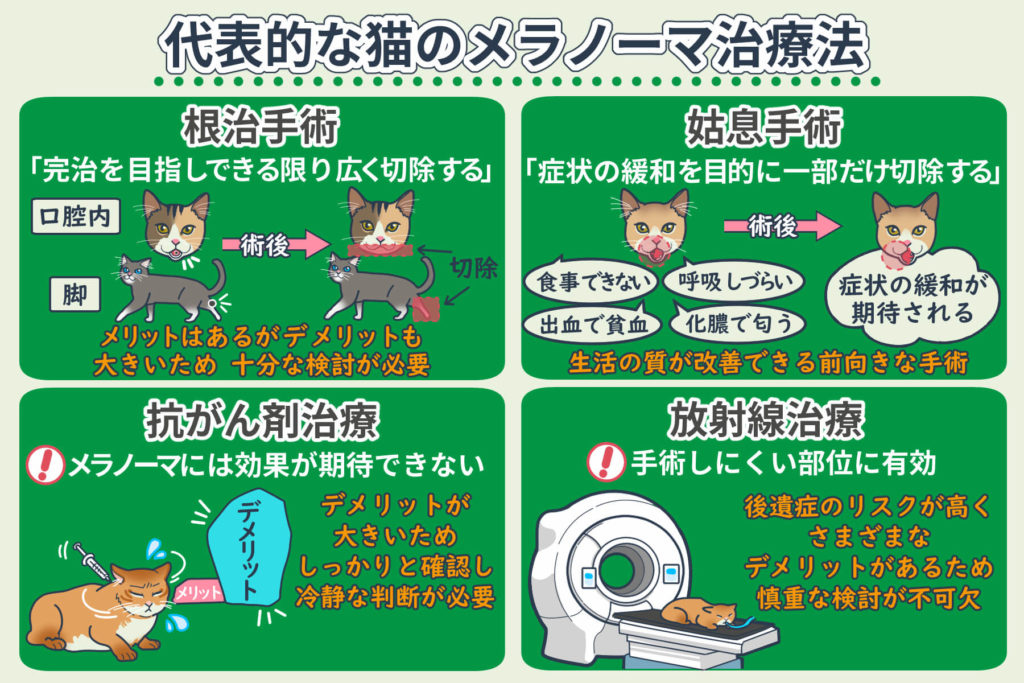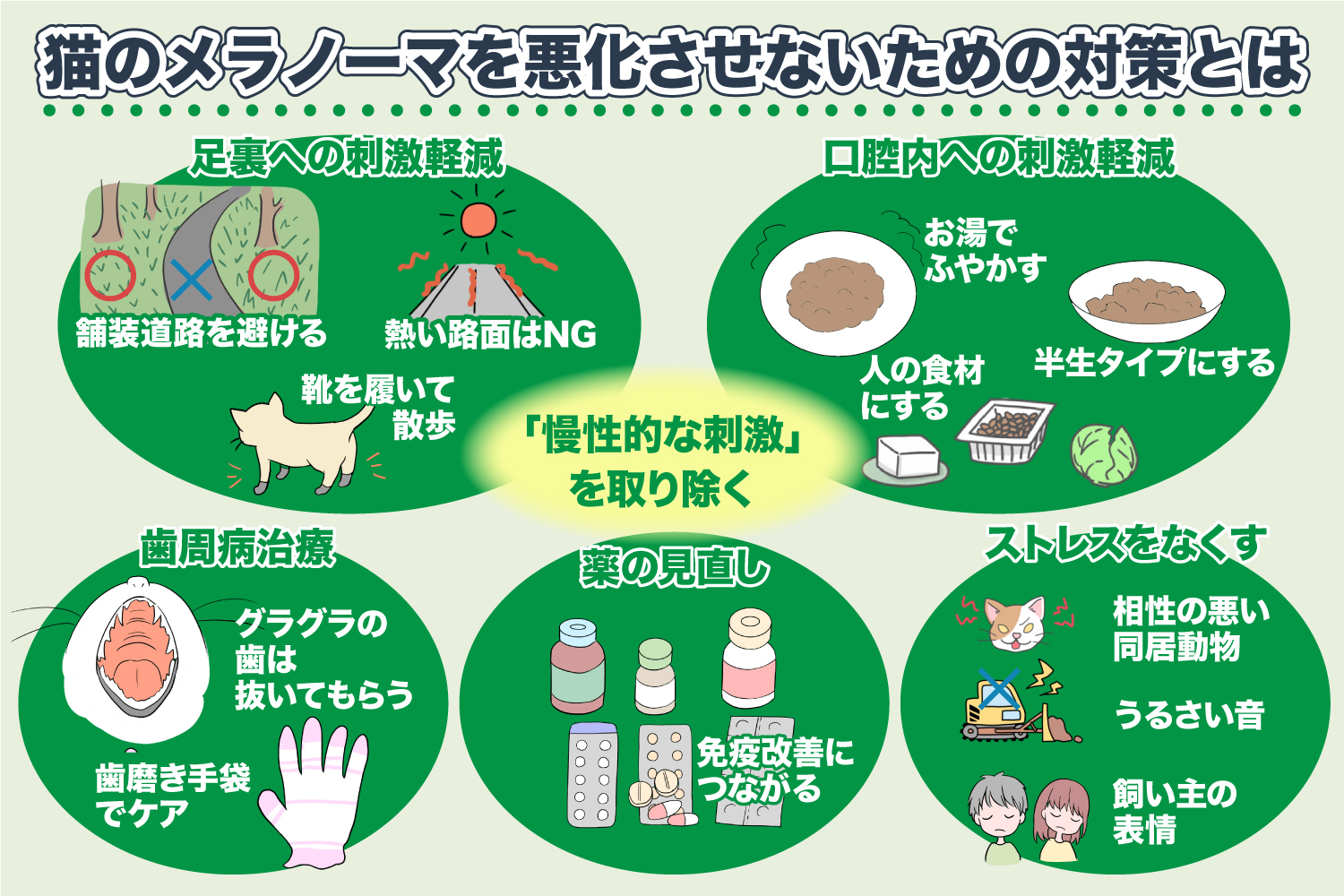Melanoma is a malignant tumor that can develop in the oral cavity or on the skin of cats. Melanoma is extremely malignant and progresses rapidly, often leading to recurrence even after surgery. However, it is believed that immune system interventions can improve the cat’s condition, maintain their quality of life (QOL), and restore their energy and appetite. In fact, there have been numerous cases where cancer in cats was controlled by implementing immune strategies using Cordy. This page summarizes the causes, symptoms, treatments, and tips for improvement and cure of melanoma, along with numerous improvement examples. We hope to be a source of support and a light of hope for everyone.
監修獣医師:林美彩 所属クリニック:chicoどうぶつ診療所

代替療法と西洋医学、両方の動物病院での勤務経験と多数のコルディの臨床経験をもつ。 モノリス在籍時には、一般的な動物医療(西洋医学)だけでは対応が困難な症例に対して多くの相談を受け、免疫の大切さを痛烈に実感する。
ペットたちの健康維持・改善のためには薬に頼った対処療法だけではなく、「普段の生活環境や食事を見直し、自宅でさまざまなケアを取り入れることで免疫力を維持し、病気にならない体づくりを目指していくことが大切である」という考えを提唱し普及活動に従事している。
所属:
目次
- 1 If Your Cat Is Diagnosed with Melanoma (Skin Cancer)
- 2 Overview of Feline Melanoma (Skin Cancer)
- 3 Characteristics of Melanoma in Cats
- 4 Symptoms and Early Detection Methods
- 5 Melanoma Examination Methods
- 6 Common Treatments for Cat Melanoma
- 7 Alternative Therapy (Natural Therapy) for Melanoma in Cats
- 8 Eliminating the Causes Worsening Melanoma in Cats
- 9 Boosting Immunity with Cordy
- 10 In Conclusion
If Your Cat Is Diagnosed with Melanoma (Skin Cancer)
In addition to melanoma, cancers that can develop on the skin include squamous cell carcinoma and mast cell tumors.
When a cat is diagnosed with melanoma or skin cancer, treatments such as surgery, chemotherapy, and radiation may be considered.
Because these cancers are aggressive, they can often recur shortly after treatment or may not respond effectively, despite the rigorous treatment that puts a significant burden on the cat.
However, it is believed that even if a cat has melanoma, the prognosis can be significantly improved, and QOL can be maintained to restore energy and appetite depending on the approach taken. There have indeed been cases where melanoma has been controlled.
Overview of Feline Melanoma (Skin Cancer)
Melanoma, which frequently occurs in cats, is a type of skin cancer also known as malignant melanoma.
It progresses rapidly, tends to recur, easily metastasizes to the lungs, and is considered one of the most aggressive types of cancer.
While the incidence in humans is a few per 100,000 people, it is slightly higher in cats, particularly those with black fur.
It is believed that chronic external irritation is the cause of melanoma.
In the oral cavity, possible irritants include hard dry food, bone chews, and chewing toys.
If it appears near the paw pads, it could be due to the impact from a strenuous walking route, or the hot asphalt in midsummer might be major contributing factors.
For humans, the cause is considered to be ultraviolet rays from the sun.
Short-haired breeds might face a slightly higher risk.
Of course, the most significant cause is not these external factors.
It is an internal issue, specifically a decline in immune function (disorder of the immune system).
When the immune system does not function properly, it cannot suppress the occurrence and growth of melanoma.
I will explain immune strategies later.
First, let’s discuss what melanoma is and the general treatment options.
Characteristics of Melanoma in Cats
Benign tumors are called melanocytomas and can be thought of as a type of mole.
Both types of tumors originate from melanocytes, which produce melanin pigments.
They are characterized by being darker than the surrounding area.
If they are larger than a mole, elevated, or have unclear boundaries, caution is required.
Particularly if it grows rapidly after onset, it should be examined by an experienced veterinarian.
Melanomas mostly occur in skin areas exposed to the external environment, such as the oral cavity and paws, and rarely originate from internal organs.
When found in the lungs, it is almost always due to metastasis from another site.
In cats, melanoma is often found inside the eyeball.
Generally speaking, melanoma is known for its rapid progression, which is true due to the large number of “cancer stem cells” thought to be involved in the rapid progression of melanoma.
For more information on cancer stem cells, considered the orchestrator of cancer, please refer to Suppressing Cancer Stem Cells to Overcome Pet Cancer.
Stimulating melanomas can speed up their growth, so avoid poking with sharp objects or handling them roughly.
Even examinations can be a form of stimulation; thus, it is best to avoid excessive testing.
Melanoma is a type of cancer that easily metastasizes to the lungs. In advanced melanomas, lung metastasis is often detected.
If lung metastasis is found, complete cure through conventional treatment alone becomes very challenging. It becomes important to build a treatment plan aiming for coexistence with melanoma.
Symptoms and Early Detection Methods

Sometimes coughing or shortness of breath can be observed. These symptoms are more likely to appear when melanoma has metastasized to the lungs. Once melanoma spreads to the lungs, it becomes very difficult to completely remove the cancer through surgery.
Because skin cancer (melanoma) progresses extremely quickly and is highly malignant, it is crucial to detect it before it advances further.
Due to the lack of obvious symptoms, detecting melanoma through changes in the pet’s condition is challenging.
Routine checks inside the mouth and on the soles of the feet are important for early detection. These areas are common sites where melanomas tend to occur, especially in dogs.
Engage regularly in physical interaction with your pet, inspecting inside their mouth, eyes, and the soles of their feet. If you notice any abnormalities, it is recommended to consult a veterinarian as soon as possible.
Many melanomas appear in locations that are visible to the naked eye.
Since melanomas are often darker in color compared to surrounding areas, this can serve as a clue for detection.
They are frequently mistaken for moles or spots, so check the following characteristics for proper differentiation.
- Recently appeared on the eyes, gums, or paw pads
- Color is mottled
- Shape is neither round nor oval
- Borders are unclear and gradually infiltrating the surrounding area
Melanomas are often discovered during regular check-ups or daily examinations. It is advisable to choose experienced veterinarians or groomers to increase the chances of early detection.
Melanoma Examination Methods
As with other skin cancers, the veterinarian first observes with the naked eye. If there is suspicion, a part or the entirety of the tumor is taken for examination.
The testing company will report the level of suspicion for melanoma.
Lung Metastasis Tests – Examination of Cat Melanoma
 To check for lung metastasis, an X-ray examination is conducted. If there is a tumor about 1 cm, it will appear on the X-ray image.
To check for lung metastasis, an X-ray examination is conducted. If there is a tumor about 1 cm, it will appear on the X-ray image.
CT scans may detect even smaller tumors that are not visible on X-rays.
However!
Even if a shadow appears in a CT scan, it does not confirm melanoma by itself.
Furthermore, even if melanoma is found, treatment can often be challenging.
CT scans involve much higher radiation exposure than X-rays and pose risks associated with general anesthesia, putting stress on the cat.
Therefore, if you are advised to undergo a CT examination, it is recommended to consult with your veterinarian about whether the benefits outweigh the risks.
The main advantage of a CT scan is determining if pursuing treatment would be meaningful.
If lung metastasis is present, procedures like eye removal, jaw amputation, or limb amputation would not lead to a cure, thus making those treatments unnecessary.
CT scans can also provide a more accurate prognosis regarding the cat’s remaining lifespan compared to X-ray examinations.
Incidentally, the cost of a CT scan is generally much higher than that of an X-ray examination.
Ultrasonography (ultrasound diagnostic imaging) is another method to examine the inside of the body.
While ultrasound can check for lymph node metastasis outside the lungs, it is nearly incapable of detecting metastasis in the lungs. This is because lungs filled with air are the most challenging area for ultrasound to examine.
Common Treatments for Cat Melanoma

The most effective treatment is surgical intervention.
The efficacy of chemotherapy against melanoma is not very high.
Radiation therapy, which is conducted in some facilities, may also not be very helpful.
All treatments carry considerable risks.
It is recommended to consider both the benefits and risks carefully before selecting a treatment method.
Curative Surgery
Curative surgery essentially aims for complete recovery.
To minimize the risk of recurrence, the tumor and the surrounding area are excised as extensively as possible.
Naturally, there are limits to how extensively a tumor can be excised, leading to specific types of surgeries as follows:
- For oral melanoma, the entire upper or lower jaw may be removed.
- Amputation for melanoma that has developed in a limb.
You might question whether such extensive excision is necessary, but the invasive nature of melanoma is incredibly high.
Even with such measures, there are often cases where a small number of cancer cells remain, leading to recurrence despite undergoing a radical surgery.
There is no doubt that radical surgery significantly reduces the number of cancer cells.
Therefore, even if recurrence occurs, the time until recurrence can be significantly extended. It is possible that melanoma will not recur at all during the pet’s lifetime.
If postoperative immune strategies are thoroughly implemented to halt the cancer’s progression, there is also the potential to spend the rest of the pet’s life without recurrence.
A point to note is that anesthesia during surgery greatly reduces immune function.
By rapidly restoring immune strength post-surgery and realigning the compromised immune system, the risks of melanoma recurrence and metastasis can be greatly minimized.
By administering Cordy, you may support the immune system to help reduce the risk of melanoma recurrence and metastasis.
While radical surgery has its benefits, it also has the following drawbacks, which means not all pet owners choose this option.
It’s important to receive thorough explanations from your veterinarian to decide whether the surgery is suitable for your pet.
- The dog’s appearance may change drastically.
- Potential decrease in Quality of Life (QOL).
- Difficulties in walking due to limb amputation.
- Inability to eat normally due to jaw removal.
- If lung metastasis was overlooked, the surgery might prove futile.
Palliative Surgery
Palliative surgery is also known as debulking surgery, where only part of the tumor is removed.
Since it is surgery with the premise of leaving cancer cells behind, it cannot achieve complete cure through surgery alone.
The aim is to temporarily resolve issues caused by the tumor.
For example, the following symptoms may be alleviated through palliative surgery:
- The tumor obstructs eating or breathing.
- The tumor is bleeding continuously, causing anemia.
- The tumor is infected and emitting an odor.
Many might not have a positive image of the term palliative, but palliative surgery is a proactive procedure aimed at improving QOL, helping both the owner and their beloved dog enjoy better times together.
Tooth extraction can also be considered a type of palliative surgery. Tooth extraction might significantly slow the progression of oral melanoma.
Melanoma Treatment for Cats: Chemotherapy
To be frank, chemotherapy is not expected to be very effective against melanoma.
As mentioned before, melanoma is a type of cancer with many “cancer stem cells.” Cancer stem cells exhibit strong resistance to chemotherapy.
Even if there is some response, the disadvantages (side effects) caused by chemotherapy often outweigh the benefits in most cases.
I have even received reports of dogs in good health passing away a few days after chemotherapy was administered.
To avoid such situations,
- Ensure there are no risks associated with the proposed chemotherapy treatment,
- Confirm that the treatment will not cause adverse effects due to side effects,
- Ensure that the treatment will not hasten the end of life.
It is recommended to thoroughly check for these potential disadvantages.
If the pet is anemic, has low albumin levels, or has decreased liver or kidney function, side effects are more likely to be severe, increasing the risk.
In such cases, a more cautious approach is desirable.
If your veterinarian recommends chemotherapy, please take the time to read articles summarizing the side effects of chemotherapy.
Treatment of Melanoma in Cats: Radiation Therapy
When melanoma has progressed to areas that are difficult to operate on, radiation therapy may be suggested.
For example, if oral melanoma has extensively infiltrated areas near the eyes, surgery with adequate margins is not possible. In such cases, radiation therapy is still an option.
However, since it is difficult to completely eliminate cancer cells with radiation therapy, it is not considered a curative treatment.
Additionally, it can damage normal tissues, often resulting in aftereffects.
In the case of oral melanoma, radiation targeting the eye can cause dry eye (reduced tear production), vision impairment, or blindness.
Cats cannot verbally communicate, making it challenging to understand, but dry mouth (reduced saliva production), altered taste, and altered smell are not uncommon.
In human radiation therapy, treatment is administered gradually over several days.
In contrast, cats receive intense radiation in just a few sessions, making aftereffects more likely.
Due to these and other reasons, careful consideration is necessary when opting for radiation therapy.
- General anesthesia is required for each radiation session
- The risk that radiation exposure may accelerate immune suppression
- High cost relative to effectiveness
Alternative Therapy (Natural Therapy) for Melanoma in Cats
As the name suggests, alternative therapy refers to treatments that substitute conventional therapies.
Various treatments have been devised and are being carried out in some advanced animal hospitals.
Many alternative therapies have a lighter burden on the body, allowing for the possibility of combining several treatments simultaneously.
The low level of damage means that these therapies are less dependent on the stage or condition of the disease. Alternative therapies can be implemented before surgery, to prevent recurrence after surgery, and in cases where surgery is not possible or where there are pulmonary metastases.
We strongly recommend considering alternative therapies in the following situations:
- When there are complications and conventional treatment poses high risks
- When aiming to coexist with the cancer
- When prioritizing the avoidance of decreased quality of life (QOL)
- Before a definitive diagnosis is made
- When the diagnosis doesn’t seem quite convincing
Dietary Therapy
 The goals are to slow down the growth of cancer, build strength, and improve anemia and albumin levels.
The goals are to slow down the growth of cancer, build strength, and improve anemia and albumin levels.
Our company and some animal hospitals place a significant emphasis on nutritional approaches as the foundation of treatment.
The primary energy source for cancer is carbohydrates. A diet therapy that limits carbohydrates as much as possible carries considerable significance from a scientific perspective.
With virtually no disadvantages, it’s worth trying.
If your pet can accept this without stress, give it a try. If it seems too stressful, consider implementing just part of it.
You may overcome this with some adjustments in the seasoning methods or the temperature of the food.
While this dietary therapy requires more effort compared to the convenience of dry food, it is not fundamentally difficult.
Please consider it as a part of the treatment and spend a little time on it. It won’t be a waste.
To help reduce the hassle even a little, we have collaborated with animal hospitals to create a list of ingredients. Please take a look.
Pets and the Principle of Dietary Therapy – Ingredients to Fight Cancer
Eliminating the Causes Worsening Melanoma in Cats

The cause of melanoma is believed to be chronic irritation.
Any treatment will decrease in effectiveness unless this is removed. Below, I present the causes and countermeasures for melanoma for your reference.
Reducing Irritation to the Soles of the Feet
Try to avoid paved roads as much as possible and choose walking routes with soft soil or grass to reduce irritation. Walking on hot surfaces should be strictly avoided.
Not only heat stimuli but also chemical irritants from asphalt can be a concern, although ideal walking routes are not available everywhere. How about having them wear shoes only during walks?
Reducing Oral Irritation
If there is melanoma in the oral cavity, it is safer to avoid dry, hard food. The tumor might enlarge due to irritation.
One way is to soak the food in warm water or switch to semi-moist types, but consider switching to human-grade food if possible.
Various chemicals included in pet food might also affect the worsening of melanoma.
These chemicals are added to prevent dog food from rotting, molding, or becoming infested with pests. They might include substances that are not allowed in human food or might be present in volumes exceeding human standards.
Treatment for Periodontal Disease
Inflammation from periodontal disease might also act as chronic irritation. If you have any teeth that are already loose, it is advisable to have the veterinarian extract them.
If a tooth falls out when no one is around, there is a risk of severe bleeding.
Regular oral care should be conducted to counter periodontal disease. I understand that many pets dislike brushing, but toothbrush gloves are great because they allow you to make tooth brushing an enjoyable bonding time.
Why not give them a try?
Reviewing Medication
All medications have a poisonous aspect.
Some pets are on long-term antibiotic use. Antibiotics can kill both good and bad bacteria, disturbing the normal bacterial balance in the oral cavity.
This imbalance not only affects the oral cavity but also the gut, leading to reduced immunity. Long-term steroid use can also compromise the immune system.
By gradually reducing antibiotics, steroids, and other medications, you can restore immune function.
Be aware that sudden discontinuation of steroids can lead to health deterioration, so they should be tapered off slowly. Always communicate any attempts to reduce medication with your veterinarian.
Reducing Stress
Strong stress is a clear factor that lowers immunity. Since immunity is crucial for cancer suppression, stress management is essential.
If there are incompatible housemates, separate them. If there is noise from construction around, move them to a quiet room.
Also, stress from the owner can affect your cat. The owner’s sad expressions can be stressful for the cat. Engaging with them with a smile is also an essential part of treatment. Please hang in there.
Please ensure that the measures introduced on this page do not cause stress to your cat. Sometimes it’s better to proceed slowly and help them get used to changes gradually.
Boosting Immunity with Cordy
When your beloved cat has melanoma, boosting immunity can improve their QOL (quality of life).
There are many consultations from people whose cats had a recurrence after surgery, whose cats underwent ineffective chemotherapy and the disease progressed, or who were told nothing could be done.
Generally, melanoma is considered highly malignant and progresses rapidly, leading to poor prognosis.
However, we believe that by properly boosting the immune system, we can help your dog regain its appetite and vitality, allowing it to live its life to the fullest.
- Had surgery for melanoma, but it recurred
- Underwent chemotherapy but became lethargic
- Received a terminal prognosis due to melanoma
If the current treatment is not working well, seems too taxing on your pet’s body, or even if the treatment is going well but you still want to improve your pet’s quality of life (QOL), we recommend considering the use of Cordy.
There have been multiple reports of long-term survival and improvement in dogs with melanoma that were given Cordy.
If you have any questions, please feel free to contact us.
In Conclusion
Melanoma is one of the most aggressive types of cancer.
While curing any cancer is challenging, melanoma is especially difficult to treat successfully.
Standard Western treatments are applied in the treatment of melanoma, but they have not yielded very good results.
It is not uncommon to find dogs that have undergone major surgery only to experience recurrence or lung metastasis.
Western treatment methods often center around the concept of thoroughly attacking cancer cells by excising them or killing them with strong toxins.
These treatments might reduce the tumor size, but they tend to overlook the overall condition of the dog’s body and the underlying causes of the cancer.
To avoid the “can’t see the forest for the trees” situation and to ensure that the priority given to treatment does not result in irreversible damage, please be cautious.
The primary goal of treatment should be to maintain your pet’s QOL and to increase the enjoyable time you spend together.
It is crucial to consider whether the treatment is worth the sacrifices made.
Most pet owners find it challenging to be satisfied with a situation where their dog loses its eyes, jaw, or limbs and becomes weakened by chemotherapy that was hoped to be beneficial.
Please be careful not to fall into the common pattern of “the tumor got smaller, but so did the flame of life.”
Even if your pet falls ill, do not simply leave everything to the veterinarian. Think together as a family about how to ensure a good time for your pet.
There are things owners can do for their pets that are not outlined on this page. If you are interested in trying something yourself, please reach out to us. We will support you as best we can.
When your pet is diagnosed with melanoma, it is crucial to focus on immune measures regardless of whether you choose to pursue treatment.
Our laboratory continues to research whether administering Cordy during periods of weakened immunity can expedite the recovery of the immune system.
We cannot predict the extent or likelihood of improvement, but at the very least, there is a significant possibility that your pet can regain its appetite and vitality.
If you are using medications such as anti-cancer drugs, steroids, or antibiotics, there are also concerns about liver function deterioration.
In such cases, combining with Placental extract powder from domestically-produced SPF pigs may help minimize liver damage.
Even in pets with already deteriorated liver values, there are numerous cases where liver function improved within about a month after using the placental extract powder from domestically-produced SPF pigs.
Moreover, since melanoma often involves inflammation, providing EPA/DHA Krill Oil extracted from Antarctic Krill, which has anti-inflammatory properties, might be effective as well.
Our laboratory continues to research Cordy for its expected immune-modulating effects, the liver-protective effects of the placental extract powder from domestically-produced SPF pigs, and the anti-inflammatory effects of Krill Oil. If you have any questions, please contact us.
監修獣医師:林美彩 所属クリニック:chicoどうぶつ診療所

代替療法と西洋医学、両方の動物病院での勤務経験と多数のコルディの臨床経験をもつ。 モノリス在籍時には、一般的な動物医療(西洋医学)だけでは対応が困難な症例に対して多くの相談を受け、免疫の大切さを痛烈に実感する。
ペットたちの健康維持・改善のためには薬に頼った対処療法だけではなく、「普段の生活環境や食事を見直し、自宅でさまざまなケアを取り入れることで免疫力を維持し、病気にならない体づくりを目指していくことが大切である」という考えを提唱し普及活動に従事している。
所属:
- Lymph Node Metastasis of Oral Melanoma (Malignant Melanoma) in a Miniature Dachshund
- Controlling Oral Melanoma in a Dog with a Two-Month Prognosis Using Anticancer Drugs and Cordy
- Long-term Control of Oral Melanoma in Dogs without Chemotherapy
- Long-term Control of Oral Melanoma in Dogs without Surgery
- Usage Example of Oral Melanoma in Dogs – Report from Shiota Animal Hospital
- Long-term Control of Oral Melanoma in Dogs
- Controlling Oral Melanoma in Dogs with Alternative Therapy






